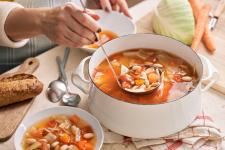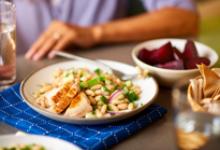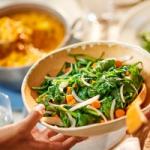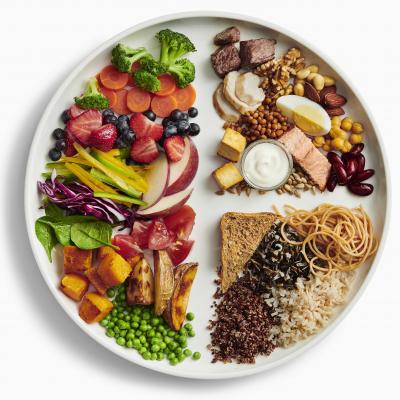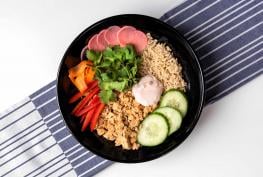Creating healthy meals and snacks can be simple when you use the Canada’s food guide plate.
How to make a healthy meal
Use the proportions of foods on the Canada’s food guide plate as a tool to help you make healthy meals or snacks.
Step 1: Make half your plate vegetables and fruits. Vegetables and fruits should always make up the largest proportion of the foods you eat throughout the day.
Step 2: Make one-quarter of your plate whole grain foods.
Step 3: Make one-quarter of your plate protein foods. Choose protein foods that come from plants more often.
Figure 1. Canada's food guide plate
Figure 1. Canada’s food guide plate – Text Description
The Canada’s food guide plate shows the proportions of foods on a plate for healthy meals or snacks.
- On half of the plate are vegetables and fruits (broccoli, carrots, blueberries, strawberries, green and yellow bell peppers, apples, red cabbage, spinach, tomatoes, potatoes, squash and green peas).
- On one-quarter of the plate are protein foods (lean meat, chicken, variety of nuts and seeds, lentils, eggs, tofu, yogurt, fish, beans).
- On the remaining one-quarter of the plate are whole grain foods (whole grain bread, whole grain pasta, wild rice, red quinoa, brown rice).
The healthy food choices shown on the plate are only examples. The size and amount of each food shown on the plate is not meant to show how much to eat at one time.
You can choose a variety of healthy foods that you enjoy. Healthy food choices can be fresh, frozen, canned or dried.
Not all meals look exactly like the Canada’s food guide plate. Use the plate proportions as a reference tool whether your meal or snack is served:
- in a bowl
- on a plate
- at a picnic
- buffet-style
- in a lunch box
- on a shared platter
How to use the Canada's food guide plate
The plate encourages you to eat many different healthy foods to help develop a healthy eating pattern and maintain your health.
You can use the plate as a guide for everything you eat, including:
- snacks
- breakfasts
- family meals
- mixed dishes
Snacks
The proportions of foods for all of your snacks throughout the day should generally follow the proportions of the Canada’s food guide plate.
Use the plate as a guide to include a vegetable or fruit at each snack. Try:
- fruit with whole grain crackers
- sliced celery with peanut butter
- cut up vegetables with hummus
- cherry tomatoes with lower fat cheese cubes
Breakfasts
You can use the plate as a guide to make half of your breakfast vegetables and fruits.
It’s all about being creative. You can try:
- having a sliced apple on top of toast with peanut butter
- including a bowl of fruit with your whole grain and protein
- adding lots of vegetables to a frittata or breakfast sandwich
- filling half of your bowl of oatmeal with berries and chopped fruit
- making a vegetable omelette with a side of fruit and half a whole grain bagel
Family meals
Use Canada’s food guide plate as a tool to make meals that your whole family can enjoy together. Remember that:
- some people need more food than others
- younger kids may require less food, so you may need to serve a mini version of the meal
No matter the type of meal or snack, make sure half of it is vegetables and fruits.
Mixed dishes
You can use the plate as a guide even when the foods in your meal are mixed together, like in a:
- soup
- stir-fry
- casserole
Think about the proportions of the foods being combined to make your mixed dish. For example, when making a stir-fry:
- make half of the food vegetables and fruits, such as:
- carrots
- pineapple
- mushrooms
- sliced peppers
- choose your protein foods, such as sliced tofu or chicken
- choose your whole grain foods, such as whole grain rice
No matter what type of dish, remember to start by making half the meal vegetables and fruits.
Make a healthy choice
What you eat on a regular basis matters for your health.
- Choose foods that have little to no added sodium, sugars or saturated fat.
- Compare the nutrition facts table on foods to choose products that are lower in sodium, sugars or saturated fat.

